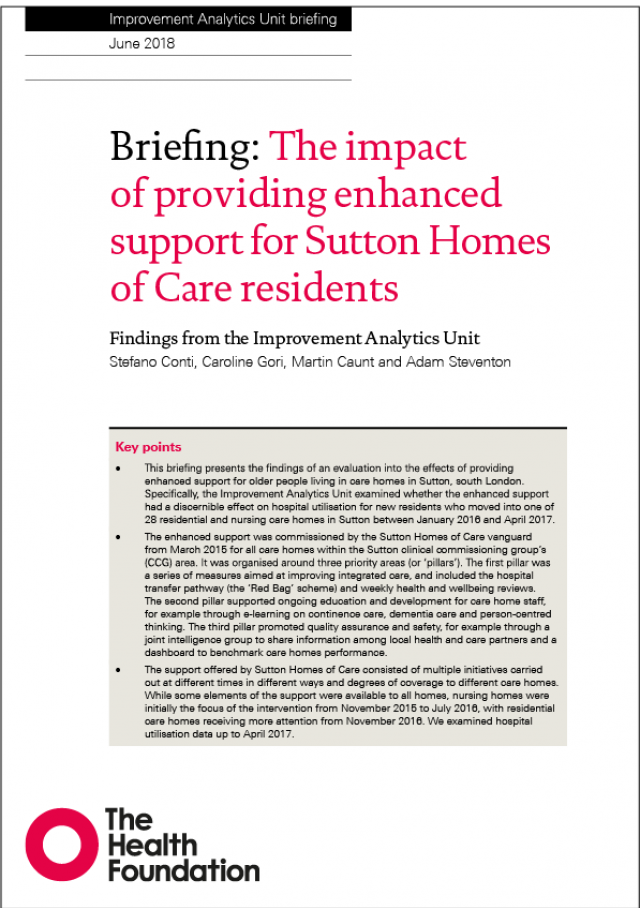The impact of providing enhanced support for Sutton Homes of Care residents Findings from the Improvement Analytics Unit
June 2018

Key points
- The Sutton residents were compared with a matched control group, which consisted of individuals broadly similar on a range of characteristics measured prior to the roll-out of the enhanced support and who moved into care homes of a similar type in comparable areas of England.
- Overall, there was no strong evidence that Sutton residents in the study used hospitals more or less frequently than the matched control group. However, there were some indications that the Sutton residents might have experienced more emergency admissions than the matched control group, including more admissions that could be considered potentially avoidable through better care outside hospital.
- Indications of higher potentially avoidable emergency admissions were strongest in nursing homes, where we estimate that Sutton residents were 122% more likely to be admitted than the control group (95% confidence interval: 19% to 327% higher).
- There were some indications that Sutton residents who moved to a care home during the second eight months of the study period experienced fewer visits to A&E departments than the corresponding control group, although this did not seem to result in fewer admissions.
- There are several possible explanations why we might not have seen significantly lower hospital use among Sutton residents than the control group. One possibility is that it was too early to see an effect. However, we cannot rule out the possibility that the enhanced support was unable to significantly reduce emergency admissions among the new Sutton residents in the study, and that there need to be changes to the nature of the interventions offered. Another possibility is that the context in which the teams were working was not conducive to there being an effect on hospital activity of new care home residents.
- Looking ahead, further quantitative analysis examining the impact on hospital outcomes since April 2017 would support Sutton CCG in its continued implementation efforts, providing further learning to enable it to deliver sustainable change. These findings need to be looked at alongside any qualitative or local evaluation to help identify whether the interventions carried out are sufficient, or if changes to implementation may be needed, to achieve the desired effect.
This report examines the effect of the Sutton Homes of Care vanguard on hospital use for new residents who moved into one of 28 Sutton care homes between January 2016 and April 2017. The report is based on an analysis from the Improvement Analytics Unit – a partnership between the Health Foundation and NHS England, set up to spread learning and improvement by applying robust statistical methods to NHS data.
Read the full list of key points
The enhanced support was commissioned by the Sutton Homes of Care vanguard for all care homes (both nursing and residential) within the Sutton clinical commissioning group’s (CCG) area. It was organised around three priority areas (or ‘pillars’). The first pillar was a series of measures aimed at improving integrated care, and included the hospital transfer pathway (the ‘Red Bag’ scheme) and weekly health and wellbeing reviews. The second pillar supported ongoing education and development for care home staff, for example through e-learning on continence care, dementia care and person-centred thinking. The third pillar promoted quality assurance and safety, for example through a joint intelligence group to share information among local health and care partners and a dashboard to benchmark care homes performance.
This report was amended on 17 April 2019 to correct row 5 of Table 2 on page 14. The numbers 60.70%, 57.70% and 43.80% have been updated to 74.07%, 74.32% and 53.99%, respectively.
Cite this publication
Further reading
Work with us
We look for talented and passionate individuals as everyone at the Health Foundation has an important role to play.
View current vacanciesThe Q community
Q is an initiative connecting people with improvement expertise across the UK.
Find out more


